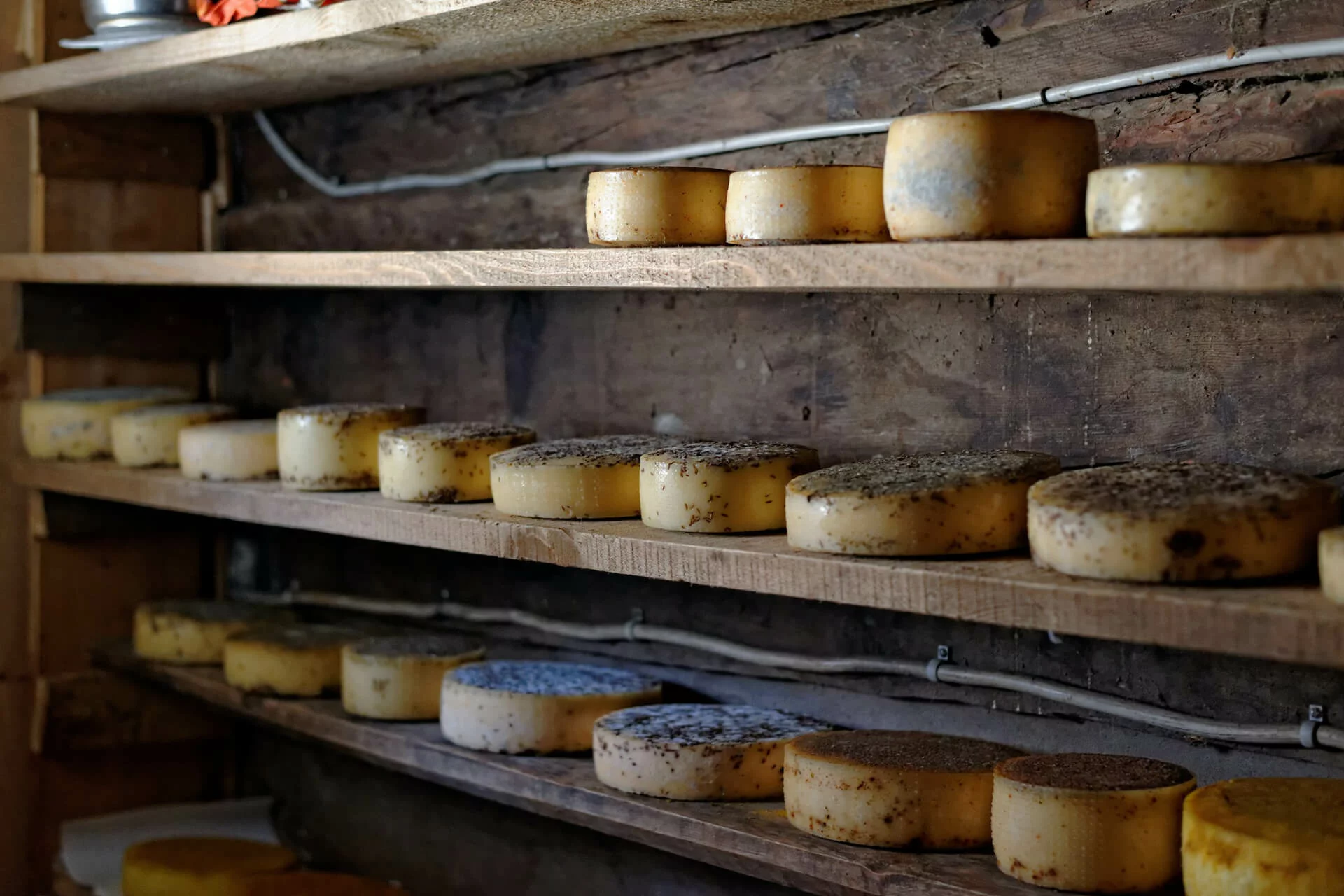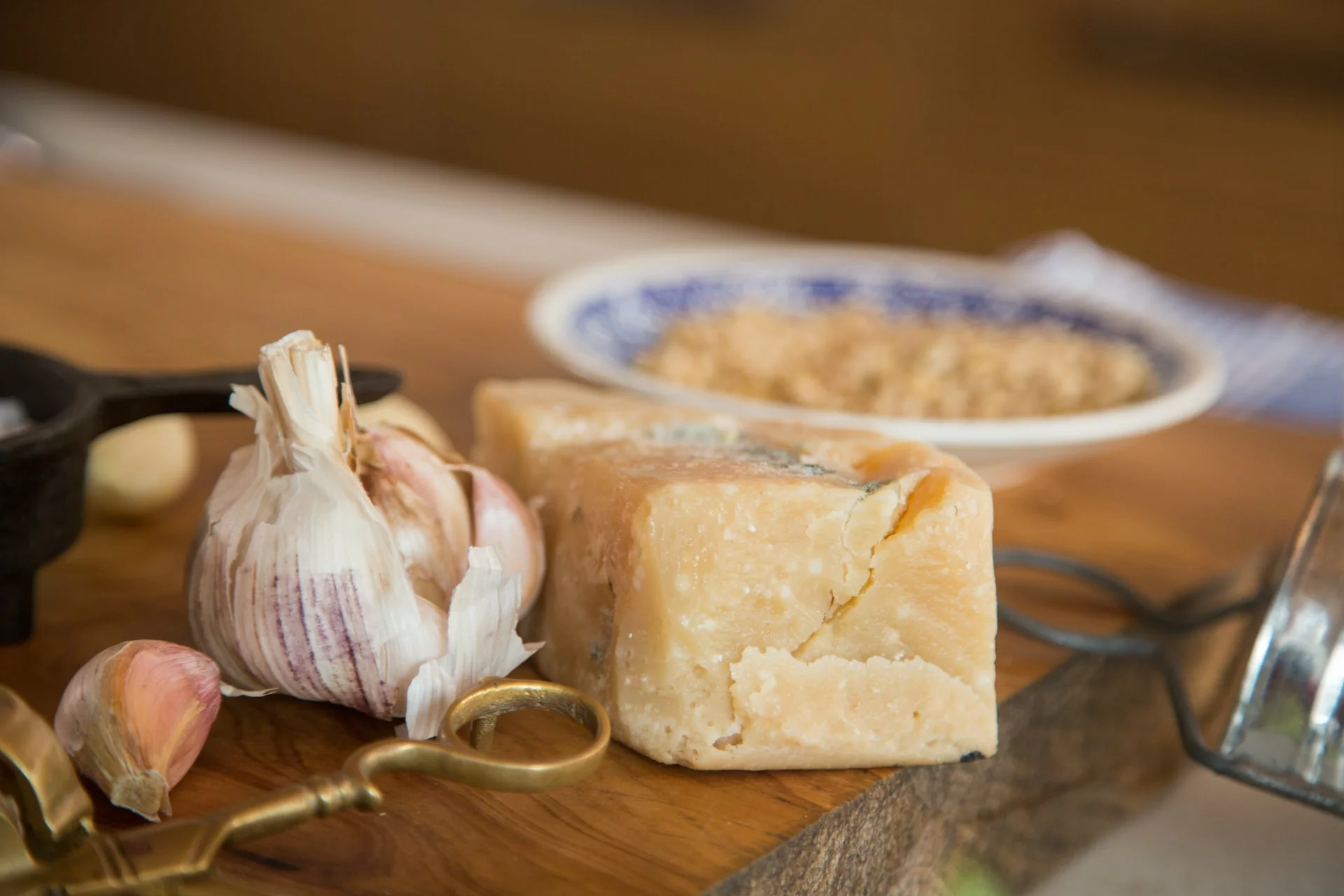Not only does it have an interesting name that rolls off the tongue, but it’s also one of the most wonderful cheeses to eat: gorgonzola. But exactly what is gorgonzola cheese?
This is a type of blue cheese, which is a favorite of many dairy lovers. It is quite popular and is often a staple on many cheeseboards. Gorgonzola has a distinct blue-green veining, an unforgettable aroma, and a crumbly, melt-in-your-mouth texture that is unique as it is enjoyable.
If you’ve heard of gorgonzola and wanted to know what makes this cheese so enjoyable and popular, then read on.
What is Gorgonzola Cheese?
Gorgonzola is an Italian cheese with the signature blue veins found in blue cheeses. Traditionally, it is produced in the northern Italian regions of Piedmont and Lombardy, including a town in Lombardy called Gorgonzola. It is made from pasteurized cow’s milk, but it can also be produced using unskimmed goat’s milk or sheep’s milk, though these are less common.
Gorgonzola cheese is firm with a crumbly texture. Its fat content usually ranges between 25% and 35%. The blue-green marbling that runs through the cheese is a mold called Penicillium roqueforti, which is used by cheesemakers to age and flavor cheese.
However, not any blue cheese can be called Gorgonzola. In order for a cheese to be classified as such, it must be awarded the DOP, or the Protected Designation of Origin (Denominiazione di Origine Protetta). If you come across cheese labeled Gorgonzola without the DOP stamp, then it is not true Gorgonzola cheese.
How is Gorgonzola Cheese Made?
Making Gorgonzola cheese takes about three to four months. It starts with curdling the pasteurized cow milk by adding yeasts and rennet, which helps to break the solids away from the water in the milk. The cheese is then gently heated to a specific temperature, around 86°F to 90°F. This triggers the marbling effect in the cheese.
The next step is cutting the curds into cubes. The leftover whey is discarded or used in other areas of cooking. Afterwards, the cheese is prepared for aging by placing the curds into molds, which are then coated and brined with sea salt to create a rind around the cheese. Once the cheese is in the mold, it is pricked with a metal skewer to ensure that marbling will run through the entire cheese.
After all of this is done, the Gorgonzola is aged for a minimum of 50 days. It can then be certified as true Gorgonzola cheese and eaten.
Types of Gorgonzola Cheese
Gorgonzola cheese does not just come in one variant. There are two distinct types, which includes:
Sweet Gorgonzola
Dolce is a sweet Gorgonzola cheese that is aged for two months. This gives it a sweet and buttery flavor, a mild and milky aroma, and a softer, spreadable texture. The mold streaks in this type of Gorgonzola cheese are distinctly blue.
Spicy Gorgonzola
Spicy Gorgonzola, on the other hand, has a strong and sharp flavor. It is also called the piccante variety and features a pungent and spicy aroma with a hard and crumbly texture. This type of Gorgonzola is aged for three months or longer. The marbling in this type of cheese is more blue-green in color.
Gorgonzola Cheese Nutrition
Here are the pertinent nutrition facts one should know about Gorgonzola cheese. For every 100 grams of Gorgonzola, you get [*]:
- Calories – 357
- Carbohydrates – 3.57 g
- Fat – 32.1 g
- Protein – 21.4 g
- Sodium – 1320 mg
- Calcium – 357 mg
Since many cheeses are higher in fat content (like Gorgonzola), it is normal to wonder if cheese is good for you. Gorgonzola cheese is quite high in calcium and vitamins, such as Vitamin A and Vitamin D. It also has essential minerals, including potassium, folate, and phosphorus. When eaten in moderate amounts, Gorgonzola is a healthy cheese!
Cheeses like Gorgonzola are also ideal for diets that focus on higher fat and lower carb consumption, such as the ketogenic diet. In this type of diet, cheese can be good for weight loss.
What Does Gorgonzola Cheese Taste Like?
Gorgonzola cheese feels creamy and has a milky taste with a nutty aroma. Since it is a product of pure cow’s milk in most cases, it often has a flavor that is slightly milder than other blue cheeses. The blue or blue-green marbling adds a sharp flavor that contrasts nicely with the cheese’s creaminess.
It can be compared to other blue cheeses such as Fourme d’Ambert or the Danish blue. Cheese lovers will, however, notice differences in sharpness and intensity when these cheeses are compared to Gorgonzola.
Depending on how long it has been aged, Gorgonzola can range from mild to sharp. As mentioned earlier, Gorgonzola Dolce is gentler in taste while the mature Gorgonzola Piccante is stronger in flavor.
Substitutes for Gorgonzola Cheese
Other blue cheeses make great substitutes for Gorgonzola. England’s Stilton cheese is made from cow’s milk, while Maytag is another blue cheese made from cow’s milk coming from the U.S. Roquefort is a particularly popular French blue cheese, but it is made from sheep’s milk instead of cow’s milk.
When substituting Gorgonzola, look for a similar blue cheese that has approximately the same aging to get as close to the flavor that you prefer.
What is Gorgonzola Gorgonzola Used for?
This cheese is often considered a dessert cheese as it is usually served on cheese platters towards the end of a meal. You can spread it on crackers or crostini and pair it with fruits like figs and pears. It also goes well with nuts and is delicious in salads!
Since Gorgonzola has a high moisture content, it melts quite smoothly. This has made it popular in cooking various dishes. It is ideal for making cheese sauces and can be used as a topping on pizzas, pastas, risottos, and more. Gorgonzola is also one of the best cheeses for snacking and can be included on charcuterie or cheese boards.
How to Store Gorgonzola Cheese
To store your Gorgonzola cheese, wrap it using foil, parchment, or wax paper, and store it in the fridge. When stored this way, Gorgonzola can last between three to four weeks. It is best to take it out of the refrigerator and allow it to come down to room temperature for at least an hour before serving.
Frequently Asked Questions
Below are frequently asked questions on Gorgonzola cheese.
What is the difference between blue cheese and Gorgonzola?
The main difference between other blue cheeses and Gorgonzola is that the latter has a milder taste and a softer texture. Other varieties of blue cheese are often sharper and harder in texture.
Is Gorgonzola hard to digest?
DOP-certified Gorgonzola contains limited amounts of lactose, which makes it a well-tolerated cheese, even for those who are lactose intolerant.
Is Gorgonzola pasteurized?
Traditional Gorgonzola is pasteurized. This allows it to have a longer shelf life and to kill off harmful bacteria. However, pasteurizing milk can sometimes rid cheeses of more unique and complex flavors, which is part of what gives Gorgonzola its milder taste.
The Bottom Line
Whether you choose the dolce or piccante variant, you’re sure to enjoy Gorgonzola cheese in whatever way you prepare it. The contrast between the mild and creamy cheese and its sharp blue marbling lends a unique flavor to many dishes. In this sense, Gorgonzola cheese can certainly hold its own in the world of blue cheese.
If you’re a fan of snacking on cheese, then give Käze Cheese a try. There are many flavors to choose from that will definitely hit the spot when you get a craving for cheese!




